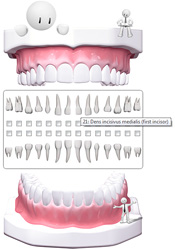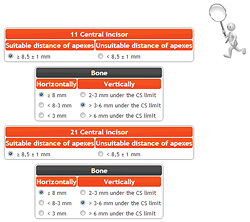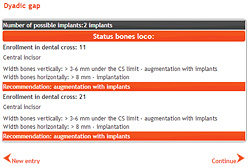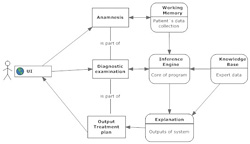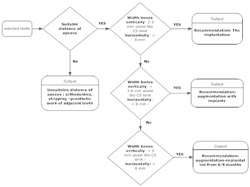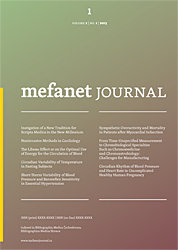
MEFANET Journal 2013; 1(1): 11–14
ORIGINAL ARTICLE
Clinical decision support system in dental implantology
Alexandra Polášková1, Jitka Feberová1, Taťjána Dostálová2,*, Pavel Kříž2, Michaela Seydlová2
1 Charles University Computer Centre, 2nd Faculty of Medicine, Charles University in Prague, Prague, Czech Republic
2 Department of Stomatology, 2nd Faculty of Medicine, Charles University in Prague, Prague, Czech Republic
* Corresponding author: Tatjana.Dostalova@fnmotol.cz
Abstract
Article history:
Received 12 March 2013
Revised 29 May 2013
Accepted 31 May 2013
Available online 4 June 2013
Peer review:
Sonia Bartáková, Jaroslav Majerník
 Download PDF
Download PDF
Implantology is rapidly developing interdisciplinary field providing enormous amounts of data to be classified, evaluated and interpreted. The analysis of clinical data remains a big challenge, because each new system has specific requirements. The aim of study was prepare specific tool for treatment planning. Decision support system is built on Expert system. It is interactive software which provides clinical recommendations and treatment planning. Expert systems are knowledge-based computer programs designed to provide assistance in diagnosis and treatment planning. These systems are used for health care (dentistry, medicine, pharmacy etc.). The application contained the medical history analysis to obtaining information useful in formulating a diagnosis and providing implant insertion and prosthetic reconstruction to the patient; the diagnostic examination of dental implant procedure; implant positioning diagnosis – 3-D measurement; diagnostic information for treatment planning; treatment plan in the form of objective measurement of implant placement that helps surgeon and prosthodontics. The decision algorithm implemented by programming language is used. Core of program is an expert knowledge programming like a decision tree. The analysis of the decision-making process for implant treatment in general practice is prepared and analyzed.
Keywords
decision support system, dentistry, implantology
Introduction
Implantology is rapidly developing interdisciplinary field providing enormous amounts of data to be classified, evaluated and interpreted. Approaches offered by dentistry and also by dentoalveolar surgery and prosthodontics data analysis and treatment are therefore of extreme interest. Numerous methods are now available as open source tools for data evaluation ready to support the various treatment plans. The analysis of clinical data remains a big challenge, because each new system has specific requirements. The aim of study is to prepare specific tool for treatment planning. This tool is web-based application developed for using knowledge base (expert knowledge) and solving included data by user and making decision and recommendations in treatment. The tool is kind of DSS (Decision support system) that is classified as clinical considered DSS (using knowledge base and inference engine) [1]. There are more than 30 decision support systems in Dentistry mentioned in literature, which are classified to seven subcategories according to special attributes identified by White [2] (Table 1).
Table 1: Seven subcategories classified by White
|
Subcategory |
|
|
A |
Dental emergencies and trauma |
|
B |
Oral – facial pain |
|
C |
Oral medicine |
|
D |
Oral radiology |
|
E |
Orthodontic |
|
F |
Pulpal diagnosis |
|
G |
Restorative dentistry |
We have found out only one DSS regarding dental implantology in literature; a pilot study for preoperative planning software for oral implanatology. They developed software by Microsoft tools (C++, VTK and ITK) [3]. This software could not be useable in different operating system only in Windows; this could be first limit for usability and operability.
We have decided build standard web application which is accessible through online interface (it has only one restriction; access to Internet). System is available on all platforms and operating systems.
Our system is designed to provide recommendations for application of the implant based on anamnesis and diagnostic medical examination. This system, which leads the patient and his physician by the decision, should provide optimal dental rehabilitation. It is based on a number of following factors; Examination of the patient (anamnesis and overall health status of the patient), Decision-making supportive system in dental implantology (recommendation to implant), Final protocol [4].
The aim of study is to prepare new expert system which could be practically used in dental clinic treatment planning.
Methods
Decision-making supportive system in dental implantology is divided into following three modules:
First module is anamnesis including questions regarding patient illness (interactive questionnaire).
Second module is the diagnostic examination of dental implant procedure:
- First step is select position of implant (Figure 1);
- Implant positioning diagnosis – 3-D measurement (Figure 2);
- Diagnostic information for treatment planning (Figure 3).
Third module is the treatment plan in the form of objective measurement of implant placement that helps surgeon and prosthodontics (considering anamnesis and overall health status of the patient based on previous form (first and third module).
We have developed architecture model based on structure model of DSS (Figure 4).
The structure model with four basic components (Inference engine, Knowledge base, Working memory and Explanation) is prepared.
System structure:
Inference engine – is core of system or the main part of Expert System or DSS (programming language – php (there are mechanisms for processing and evaluating data based on KB – knowledge base and WM – working memory).
Knowledge base – this component includes knowledge of experts.
Working memory – patient’s data collection.
Explanation – this module may explain outputs of system (recommendation for implantation of teeth based on patients.
Model has a unique structure consisting of two main parts (Figure 5):
Inference Engine – is program implemented in php which is processing input gained data from Working Memory. Data is processed of this program driven by conditions from Knowledge Base. Programming language PHP is open source with ability to run on almost all platforms. Data is collected in MySQL, open source implementation of databases. Inputs and Outputs are presented through web based interface.
Knowledge Base – is in this case a set of thresholds. Thresholds are used in Inference Engine to make decisions and to output correct result. For example, there is width threshold to determine which treatment will be better.
Programming schema is illustrated in Figure 5. It is part of decision tree, representing choice of teeth and next steps leading to the final recommendation decision. Rhomb is argument of decision based on your choice. You will get recommendation and you may go on to next step to final decision.
Discussion and conclusion
A clinical decision support system (CDSS) is an application designed to assist health professionals in decision-making tasks as in regard to diagnosis and treatment planning [5]. Focusing on dentistry, there are not many relevant studies exploring the potentials of CDSS. Brickley et al. [6] developed a neural network application to provide decision support for lower third molar treatment-planning. Benn [7] prepared CDSS examples for caries management, and Finkeissen et al. [8] evaluated intelligent dental treatment planning. All systems are base mainly on dental odontology – tooth anatomy, disease, and treatment and are semantically linked by the Relation Ontology [9,10] and some application-specific properties.
CDSS for dental implantology planning is based on comprehensive appraisal of the morphologic features of the proposed implantation site: the quality and quantity of available bone, the presence of pathoses, the inclination of the alveolar process, and the relative location of anatomic structures to the site of implantation. It is known that decision can be qualified as either “effective” or “preference sensitive”, to the extent that it is related to scientific evidence of benefits and risks to patients [11]. Our system can practically help to receive objective treatment plan including implant objectification in general practice. The presented data support the clinical implants planning and warrant more comprehensive evaluation of future therapy.
Acknowledgements
The study was supported by project No. CSM 54 and 00064203 (the Motol University Hospital).
References
[1] Shibl R, Lawley M, Debuse J. Factors influencing decision support system acceptance. Decis Support Syst 2013; 54(2): 953–961.
[2] Vikram K, Karjodkar FR. Decision support systems in dental decision making: an introduction. J Evid Based Dent Pract 2009; 9(2): 73–76.
[3] Chen X, Yuan J, Wang C, Huang Y, Kang L. Modular preoperative planning software for computer-aided oral implantology and the application of a novel stereolithographic template: a pilot study. Clin Implant Dent Relat Res 2010; 12(3): 181–193.
[4] Dostálová T, Feberová J, Polášková A. Publication system to support implantations. [Online]. Available at WWW: <http://dlcv.cuni.cz/course/view.php?id=29>.
[5] Park SG, Lee S, Kim MK, Kim HG. Shared decision support system on dental restoration. Expert Syst Appl 2012; 39(14): 11775–11781.
[6] Brickley MR, Shepherd JP. Performance of a neural network trained to make third-molar treatment-planning decisions. Med Decis Making 1996; 16(2): 153–160.
[7] Benn DK. Applying evidence-based dentistry to caries management in dental practice. A computerized approach. J Am Dent Assoc 2002; 133(11): 1543–1548.
[8] Finkeissen E, Stamm I, Müssig M, Streicher J, Koke U, Helmstetter C, Hassfeld S, Wetter T. AIDA: Web agents in dental treatment planning. Adv Dent Res 2003; 17(1): 74–76.
[9] Smith B, Ceusters W, Klagges B, Köhler J, Kumar A, Lomax J, Mungall C, Neuhaus F, Rector AL, Rosse C. Relations in biomedical ontologies. Genome Biol 2005; 6(5): R46.
[10] Hippmann R, Dostalova T, Zvarova J, Nagy M, Seydlova M, Hanzlicek P, Kriz P, Smidl L, Trmal J. Voice-supported electronic health record for temporomandibular joint disorders. Methods Inf Med 2010; 49(2): 168–172.
[11] O’Connor AM, Légaré F, Stacey D. Risk communication in practice: the contribution of decision aids. BMJ 2003; 327(7417): 736–740.
Please cite as:
Polášková A, Feberová J, Dostálová T, Kříž P, Seydlová M. Clinical decision support system in dental implantology. MEFANET Journal 2013; 1(1): 11–14. Available at WWW: http://mj.mefanet.cz/mj-01130312.
This is an open-access article distributed under the terms of the Creative Commons Attribution-NonCommercial-ShareAlike 3.0 License (http://creativecommons.org/licenses/by-nc-sa/3.0/), which permits unrestricted use, distribution, and reproduction in any medium, provided the original work, first published in the MEFANET Journal, is properly cited. The complete bibliographic information, a link to the original publication on http://www.mj.mefanet.cz/, as well as this copyright and license information must be included.
